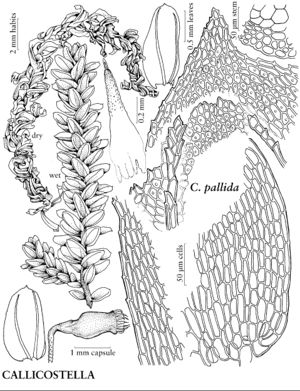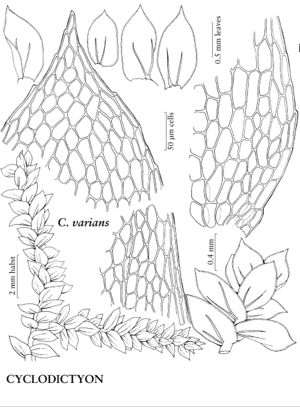Plants in small to medium-sized mats, pleurocarpous, white, yellowish, pale green, bluish, or brownish. Primary-stems green, creeping, spreading, regularly or irregularly pinnate; hyalodermis present or absent, central cylinder cells large, walls thin, central strand absent; paraphyllia absent; pseudoparaphyllia absent [filamentous]; ± radiculose; axillary hairs of 2–several cells, basal-cell small, brown, distal cell elongate, hyaline. Secondary stems spreading, suberect, frondose, not or sparingly branched. Leaves ± complanate, often dorsiventrally oriented, somewhat dimorphic; vertical (dorsal and ventral) leaves erect, broadly oblong, oblong-ovate, or ovatelanceolate; lateral leaves erect-spreading to spreading, narrower; margins often dentate; apex usually acuminate; costa double, well developed; alar cells undifferentiated; laminal cells isodiametric or linear-rhomboidal, smooth to 1-papillose, walls lax to firm; marginal cells forming border or not. Sexual condition polygamous: autoicous, synoicous, or dioicous. Seta red to reddish yellow, elongate, smooth or papillose-scabrous. Capsule inclined, horizontal, pendulous, or sometimes erect, ovoid to oblong-cylindric, smooth, contracted below mouth when dry; annulus absent or narrow; operculum conic, rostrate to subulate; peristome double, dark red or redbrown; exostome teeth 16, lanceolate to lance-subulate, furrowed, cross-striolate basally, papillose distally, trabeculate, sometimes bordered; endostome yellow to yellowbrown, finely papillose to nearly smooth, basal membrane high, segments lanceolate, as long as teeth, keeled, cilia absent. Calyptra conic-mitrate to mitrate-campanulate, base lobed or fringed, smooth or papillose-scabrous distally, naked. Spores smooth to finely papillose.
Distribution
se United States, Mexico, West Indies, Bermuda, Central America, South America, Eurasia, Africa, Pacific Islands
Discussion
Genera 21, species ca. 400 (3 genera, 3 species in the flora).
Pilotrichaceae are characterized by a double costa, stem hyalodermis usually present, undifferentiated alar region, and hairy calyptra (the calyptra is naked in the three species represented in the flora area). The leaves are usually complanate with a differentiation between lateral and dorsal or ventral leaves, and the seta is variously papillose to spinose. Recent changes in the circumscription of Pilotrichaceae were outlined by T. de Freitas Vaz-Imbassahy and D. P. da Costa (2009) and H. A. Miller (1971). W. R. Buck (1998) suggested two central lines of evolution in the family by which genera may be organized based on the presence or absence of a differentiated outer layer of inflated stem cortical cells (a hyalodermis), compared to an outer cortical layer of relatively thick-walled cells. Critical literature associated with the pre-1971 concept of Hookeriaceae in the flora area is that of W. H. Welch (1962, 1966, 1972).
Selected References
None.
Lower Taxa
Illustrations
| Family ⠉ | Taxon | Illustrator ⠉ | |
|---|---|---|---|
 | Pilotrichaceae | Callicostella pallida | Patricia M. Eckel |
 | Pilotrichaceae | Cyclodictyon varians | Patricia M. Eckel |
 | Pilotrichaceae | Trachyxiphium hypnaceum | Patricia M. Eckel |
Key
| 1 | Laminal cells 1-papillose on both surfaces; leaf apices rounded-truncate, short-apiculate; setae scabrous; hyalodermis absent. | Callicostella |
| 1 | Laminal cells smooth or sometimes prorulose by projecting distal cell ends; leaf apices short- to long-acuminate; setae smooth; hyalodermis present or absent | > 2 |
| 2 | Leaf apices short-acuminate; margins entire or serrulate distally; marginal cells forming border; laminal cells hexagonal or oblong-hexagonal, lax; hyalodermis present. | Cyclodictyon |
| 2 | Leaf apices slenderly long-acuminate; margins serrulate in distal 1/3; marginal cells not forming border; laminal cells narrow, long-rhomboidal to linear, not noticeably lax; hyalodermis absent. | Trachyxiphium |